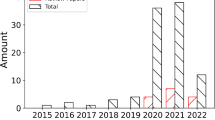Abstract
There is extensive research going on in the field of automatic identification of plants in order to preserve the plant species which are on the verge of extinction and also to educate people or new generation farmers about the various plants growing in their vicinity. Few plants also possess certain medicinal properties which can be used by the layman to treat commonly occurring ailments. We suggest a novel leaf identification approach using combination of deep learning and conventional machine learning techniques. In this approach, the leaf image features are extracted using a neural network pre-trained on the ImageNet and then fed into the machine learning classifiers for predictions. We prepared three different models and analyzed their performance. Thereafter, we propose an ensemble approach based on stacking classifiers where the predictions of multiple classifiers were used to train a meta-classifier. This approach achieved an accuracy of 99.16% and 98.13% on the unseen samples of Swedish and Flavia datasets respectively.





Similar content being viewed by others
Data Availability
The datasets used for the study are publicly available. Name of datasets and references have been provided under Section 3.1
References
Wäldchen J, Mäder P (2018) Plant species identification using computer vision techniques: a systematic literature review. Arch Comput Methods Eng 25:507–543. https://doi.org/10.1007/s11831-016-9206-z
Sachar S, Kumar A (2020) Survey of feature extraction and classification techniques to identify plant through leaves. Expert Syst Appl 114181. https://doi.org/10.1016/j.eswa.2020.114181
Sun Y, Liu Y, Wang G, Zhang H (2017) Deep learning for plant identification in natural environment
Pearline A, Sobitha S, Vajravelu SK (2019) DDLA : dual deep learning architecture for classification of plant species. https://doi.org/10.1049/iet-ipr.2019.0346
Šulc M, Matas J (2017) Fine - grained recognition of plants from images. Plant Methods 1–14. https://doi.org/10.1186/s13007-017-0265-4
Ni F, Wang B (2018) Integral contour angle: An invariant shape descriptor for classification and retrieval of leaf images. Proc - Int Conf Image Process ICIP:1223–1227. https://doi.org/10.1109/ICIP.2018.8451605
Wang B, Gao Y (2014) Hierarchical string cuts: A translation, rotation, scale, and mirror invariant descriptor for fast shape retrieval. IEEE Trans Image Process 23:4101–4111. https://doi.org/10.1109/TIP.2014.2343457
Turkoglu M, Hanbay D (2019) Leaf-based plant species recognition based on improved local binary pattern and extreme learning machine. Phys A Stat Mech its Appl 527:121297. https://doi.org/10.1016/j.physa.2019.121297
She Y, Wang X, Gui T, Cai J (2019) Lawn plant identification and segmentation based on least squares support vector machine and multifeature fusion. J Electron Imaging 28:1. https://doi.org/10.1117/1.jei.28.2.023034
Ward D, Moghadam P, Hudson N (n.d.) Deep leaf segmentation using synthetic data
Bodhwani V, Acharjya DP, Bodhwani U (2019) Deep residual networks for plant identification. Procedia Comput Sci 152:186–194. https://doi.org/10.1016/j.procs.2019.05.042
Beikmohammadi A, Faez K (2018) Leaf classification for plant recognition with deep transfer learning. Proc - 2018 4th Iran Conf Signal Process Intell Syst ICSPIS 2018 21–26. https://doi.org/10.1109/ICSPIS.2018.8700547
Tan JW, Chang SW, Abdul-Kareem S et al (2020) Deep learning for plant species classification using leaf vein morphometric. IEEE/ACM Trans Comput Biol Bioinforma 17:82–90. https://doi.org/10.1109/TCBB.2018.2848653
Söderkvist OJO (2001) Computer vision classification of leaves from swedish trees. 74
Wu SG, Bao FS, Xu EY, et al (2007) A leaf recognition algorithm for plant classification using probabilistic neural network. ISSPIT 2007 - 2007 IEEE Int Symp Signal Process Inf Technol 11–16. https://doi.org/10.1109/ISSPIT.2007.4458016
Chen T, Guestrin C (2016) XGBoost: A scalable tree boosting system. In: Proceedings of the ACM SIGKDD International Conference on Knowledge Discovery and Data Mining. Association for Computing Machinery, pp 785–794
Naresh YG, Nagendraswamy HS (2016) Classification of medicinal plants: An approach using modified LBP with symbolic representation. Neurocomputing 173:1789–1797. https://doi.org/10.1016/j.neucom.2015.08.090
Aakif A, Khan MF (2015) Automatic classification of plants based on their leaves. Biosyst Eng 139:66–75. https://doi.org/10.1016/j.biosystemseng.2015.08.003
Ibrahim Z, Sabri N, Nabilah N, Mangshor A (2018) Leaf Recognition using Texture Features for Herbal Plant Identification. Indones J Electr Eng Comput Sci 9:152–156. https://doi.org/10.11591/ijeecs.v9.i1.pp152-156
Jasitha P, DIleep MR, DIvya M (2019) Venation Based Plant Leaves Classification Using GoogLeNet and VGG. 2019 4th IEEE Int Conf Recent Trends Electron Information, Commun Technol RTEICT 2019 - Proc 715–719. https://doi.org/10.1109/RTEICT46194.2019.9016966
Author information
Authors and Affiliations
Corresponding author
Ethics declarations
Conflicts of interests
Authors declare no competing interests.
Additional information
Publisher’s note
Springer Nature remains neutral with regard to jurisdictional claims in published maps and institutional affiliations.
Rights and permissions
Springer Nature or its licensor (e.g. a society or other partner) holds exclusive rights to this article under a publishing agreement with the author(s) or other rightsholder(s); author self-archiving of the accepted manuscript version of this article is solely governed by the terms of such publishing agreement and applicable law.
About this article
Cite this article
Sachar, S., Kumar, A. A novel transfer learning-based approach for plant species prediction using leaf images. Multimed Tools Appl 83, 40323–40336 (2024). https://doi.org/10.1007/s11042-023-17311-8
Received:
Revised:
Accepted:
Published:
Issue Date:
DOI: https://doi.org/10.1007/s11042-023-17311-8




